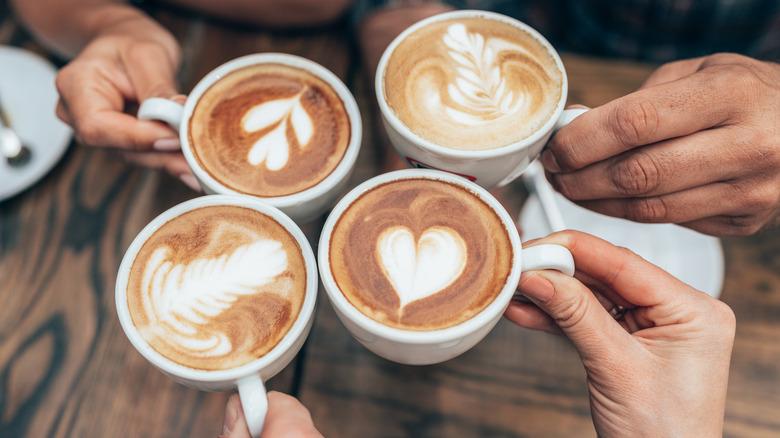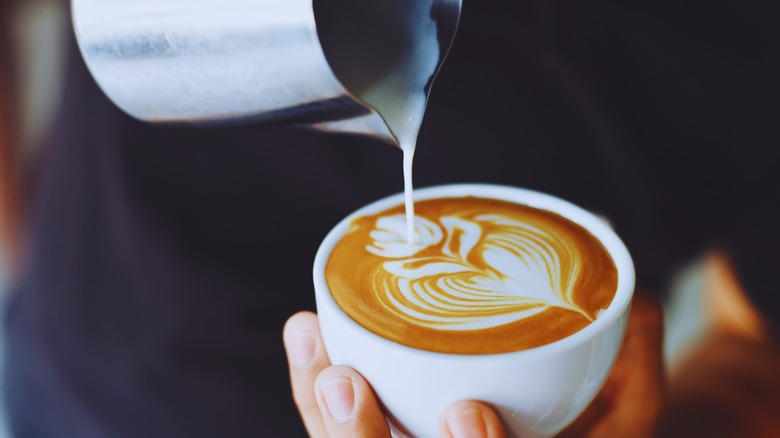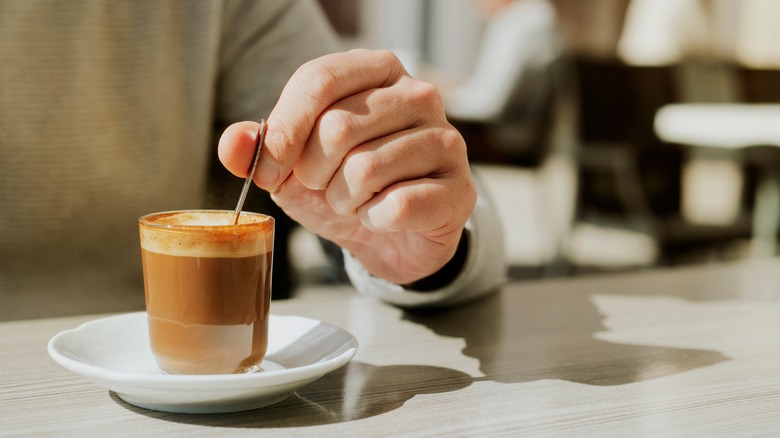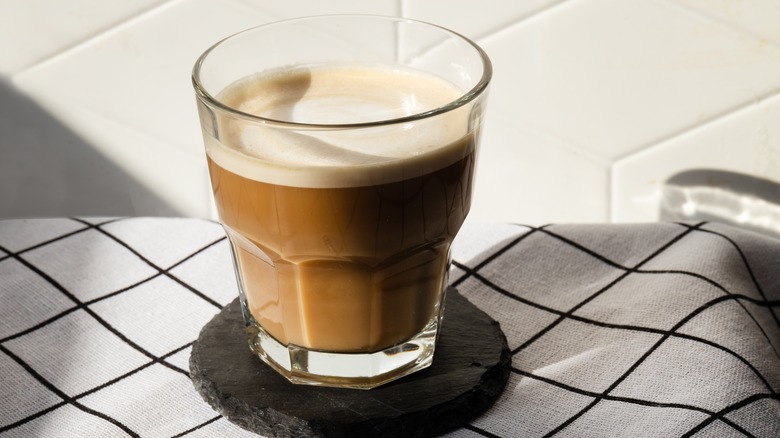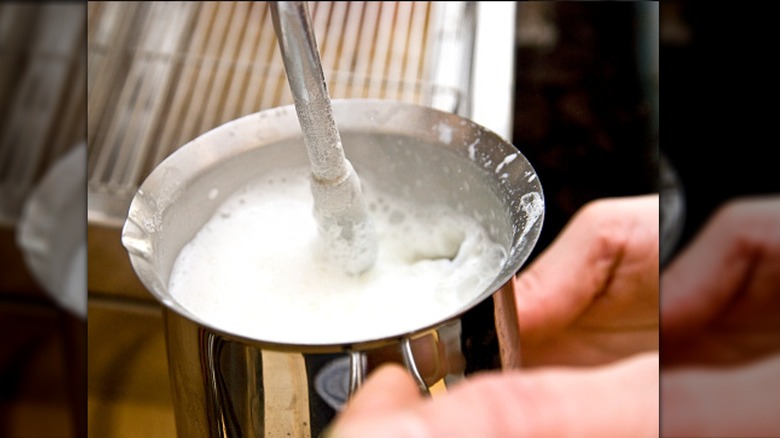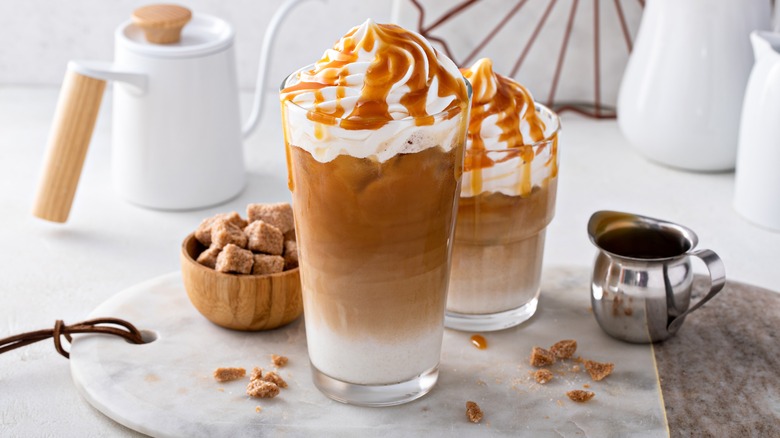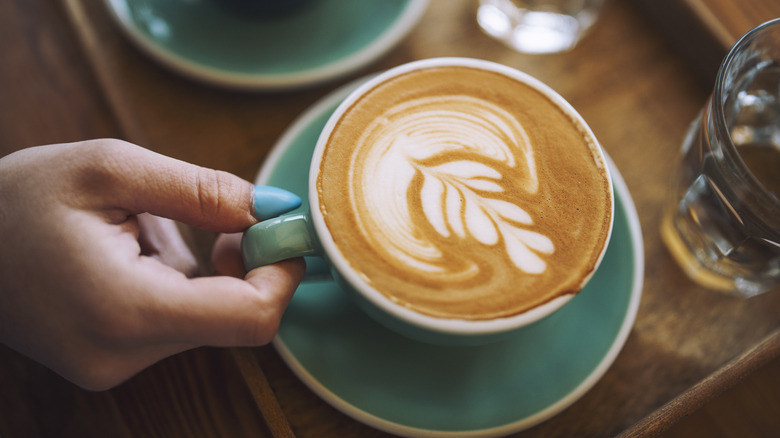Macchiato Vs Latte: What's The Difference?
Let's get one thing straight: The celebrated coffee behemoth Starbucks has done the macchiato a great disservice. No one seems sure exactly why Starbucks made up its own definition of the classic espresso beverage. The chain has been selling its caramel-loaded version of the macchiato since 1996 when it was created to commemorate the company's 25th anniversary. In the years since then, this form of the macchiato has been muddled in the collective consciousness of American coffee lovers, and as a result, the line between latte and macchiato has also been blurred. As a veteran barista, my hope is to set the record straight.
If you order an "iced caramel macchiato" from Starbucks, the drink you receive will technically be an iced latte with vanilla and caramel syrups. Traditional macchiatos never include caramel, and they are never iced. Both lattes and macchiatos are Italian in origin, and distinguishing their differences in the technical sense can be even more difficult considering the beverages are made from the same ingredients — espresso and milk. Differences in the proportions and preparation yield totally different drinks. Lattes are a larger, often sweeter, "walkaround" beverage, while macchiatos come in a tiny glass, tote a strong coffee flavor, and are made to be enjoyed in one sitting.
What is a latte?
Lattes are hand-crafted beverages made from an espresso base topped with chilled or steamed milk. In fact, "café latte" translates to "coffee milk," which is exactly what the beverage is. Lattes can be hot or iced. For iced lattes, the milk is poured directly from the jug into the glass and not manipulated by the barista in any way. To assemble iced lattes, some baristas top a glass of ice and milk with the espresso shot rather than pour the milk over the ice. Either method of preparation works and they're often used interchangeably in cafes. The result is a mild, slightly sweet flavor, but sweeteners like sugar or simple syrup can also be mixed in.
The milk is poured into a metal pitcher and placed under the steam wand to heat and froth in a hot latte. Nailing the right latte consistency is a pride point for seasoned baristas — it's a skill that takes practice to lock down. To test the consistency of your steamed milk, give the pitcher one firm slam on the counter to pop any air bubbles, then swirl the milk around with a single rotation of your fist. Good latte milk should coat the inside of the pitcher like a layer of white house paint. This consistency allows baristas to create latte art, drawing pictures on top of lattes with lush, paint-like milk.
What is a macchiato?
A macchiato is a shot of espresso with a dollop of foamed milk poured into the center. That's it. No caramel, no ice, and no whipped cream. The name macchiato translates to "stained" or "marked," and that's just what the beverage looks like — a small cup of dark brown with a white spot in the middle. The espresso shot is topped with a dollop of foamed milk heated between 140 to 150 degrees Fahrenheit.
Macchiatos are all about showcasing the flavor and aroma of quality espresso beans. Also, in the barista industry, macchiatos are regarded as the ultimate crafted espresso beverage for showcasing the prowess of the barista. With such a small glass, there is no room for error or any flavored syrups to hide behind. The milk must be steamed to the exact right texture, and the espresso shot must be pulled at the exact right moment. Too long and it'll be over-diluted; too short and the drink becomes bitter. During the interview process, coffee shop purveyors will often ask potential new hires to make a macchiato or a cortado to test their skill behind the machine.
Lattes are physically much larger than macchiatos
The most obvious distinction between lattes and macchiatos is their physical size. Lattes come in multiple sizes with 8 ounces, 12 ounces, and 16 ounces being industry standard for small, medium, and large respectively. Macchiatos, by contrast, only come in one size, are typically served in tiny ceramic mugs or shot glasses, and will not fill a regular-sized coffee cup. They're just a few inches tall. Macchiatos use a two-to-one espresso-to-milk ratio, while lattes use a one-to-three ratio. That shakes out to roughly 3 to 4 fluid ounces total for the finished drink (or as little as 1 ¼ ounces for a single-shot macchiato) versus as many as 20 ounces in an iced latte.
This size difference colors the way the two beverages are enjoyed. A latte is a slow sipper. You can nurse one for hours while working or running errands. A macchiato, on the other hand, isn't typically something you order to go. Similar to small-portioned Turkish coffee, macchiatos are designed for savoring, sipping that tiny cup-full while seated, and treating the moment as an opportunity to slow down. Macchiatos are a big player in Italian coffee culture, often enjoyed in the afternoons as a luxurious caffeine boost, or to get the day started alongside breakfast.
The milk is steamed stiffer for macchiatos than for lattes
Apart from their physical size, the biggest difference between macchiatos and lattes is the texture of the milk. For lattes, when you pour the milk from the steam pitcher into the mug or cup, the thicker part of the milk will end up on the bottom, forming the body of the latte. The less-dense microfoam will rise to the top, creating the signature frothy cap on top of the latte. To make a macchiato, the milk is steamed much stiffer. The entirety of the macchiato's milk should resemble the consistency of that frothy microfoam portion on top of a latte. Steaming milk for longer introduces more air into the milk, not unlike how whipping heavy cream for longer creates stiff peaks.
Also notably, from a barista's perspective, macchiatos and lattes can be made with alternative non-dairy plant-based milks. But, just because they can doesn't necessarily mean they should be. As mentioned earlier, macchiatos are a beverage with minimal wiggle room, and almond and skim milk don't stiffen up like whole milk. These milks might work fine for a latte, but if you're making a macchiato, whole milk is really the only way to achieve that characteristic macchiato consistency. However, if you make a non-dairy version, use soy milk or specifically marked barista-grade oat milk. These create the stiffest microfoam.
Lattes can be flavored but macchiatos can not
If you like it sweet, order a latte. But if you're in it for the strong coffee flavor, a macchiato might be more your style.
Macchiatos showcase the flavor of high-quality coffee beans. Similarly to how a few drops of water open up a top-shelf whiskey, a little steamed milk enhances and accentuates the more nuanced flavor notes in the espresso, making the macchiato a classy classic that lets the ingredients speak for themselves. Rich, dry, and slightly bitter for a true espresso taste, macchiatos are a solid fit for folks who like the flavor of cappuccinos but prefer less milk.
Standard lattes (hot or iced) contain just espresso and milk, but flavorings like caramel, vanilla, hazelnut, pumpkin spice, and lavender are popular additions typically incorporated via syrups. If you add chocolate syrup to a latte, then it becomes a mocha. These cosmetic ingredients provide a playful opportunity for intrepid baristas to get creative with new hand-crafted latte inventions and flavor pairings. Syrups like these do not belong in a macchiato.
The caffeine content can vary wildly
Caffeine content is all about how many espresso shots a drink contains, regardless of the physical size of the finished beverage. Keep this rule in mind as you place your morning Java order. Two shots of espresso per latte is commonplace in many if not most coffee shops, for any size larger than an 8-ounce small, which often are made with a single shot. However, depending on how you customize your latte order, they can contain anywhere from one to four shots. If you're curious about how many shots are in your latte, ask your barista before you order. For reference, two shots of espresso is roughly the caffeine equivalent of an 8-ounce cup of drip coffee.
Macchiatos are also typically made from either a single (solo macchiato) or double shot of espresso (doppio macchiato). So, that large milky latte might pack the same amount of caffeine as a short double-shot macchiato. Again, this is a good question for your barista to avoid an unwelcome buzz. Or, conversely, to welcome one in with open arms.
